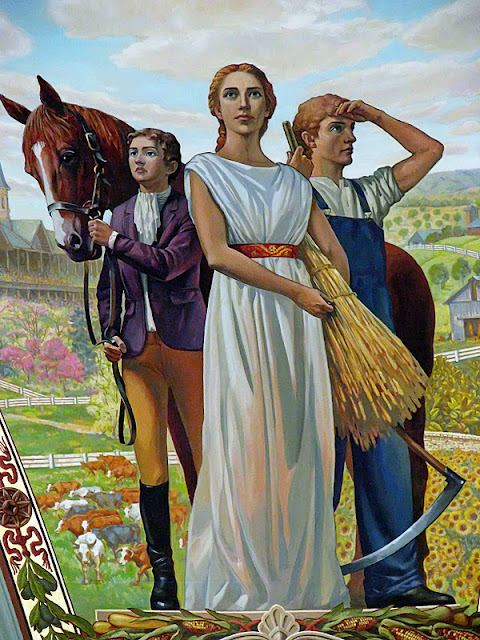Being afforded many opportunities to travel, I’ve actually seen
more than the 20 states crossed off aforementioned list. But because I haven’t yet toured their
statehouse, places like California, Nevada, South Dakota, Florida, New York and
New Jersey haven’t scored a checkmark. My
list, my rules! Since that notion is
what prompted a trip to the Bluegrass State, its Capitol was the site to which
we first headed upon arriving there.
Completed in 1910, Kentucky’s current Capitol is the fourth
permanent statehouse constructed since the Commonwealth’s statehood in 1792. It was built to replace the earlier 1830
capitol building, still standing in downtown Frankfort, which had become
inadequate to accommodate the growing state government. Designed by Frank Mills Andrews, it is considered
to be one of the most beautiful capitols in the country. His Beaux Arts design is a pleasant departure
from the many classical Greek and Roman structures I’ve seen in other capital
cities.
The exterior of the Capitol is faced in Indiana limestone
and Vermont granite. The pediment above
the entrance was designed by Charles Henry Niehaus and carved by Australian
sculptor Peter Rossack. The central
figure represents Kentucky, with Progress, History, Plenty, Law, Art and Labor
as her attendants. The animals symbolize
agriculture.
The building’s interior is open to visitors and guided tours
are available on the hour. We instead grabbed a map and opted to explore on our
own.
The capitol rotunda features sculptures of prominent
Kentuckians, including Abraham Lincoln, Jefferson Davis, Henry Clay, Ephraim
McDowell and Alben Berkley.
The dome rises more than seven stories in height (180 feet) and
was patterned after the dome of Napoleon’s tomb in Paris.
My favorite feature of any capitol building is the murals
which depict its history. The four
hand-painted murals in the Capitol’s pendentives (the triangular areas beneath
the dome) did not disappoint. Though it took
nearly 100 years for their design to be realized, the story of how they came to
be is an interesting one.
Civitas: The Light of Progress
When the Capitol was originally built, plans were made for
muralist Frank Millet—a former Harvard classmate of Kentucky’s then governor
August E. William—to design and paint murals in the Capitol rotunda. Tragically, he died on the ill-fated maiden
voyage of the Titanic on April 14,
1912 and the idea was put on hold.
Nature: The Bounty of the Land
When EverGreene Architectural Arts conducted a restoration
of the State Reception Room in 1991, Capitol officials were presented with a
sketch of how the rotunda could look with painted pendentive murals. That, however, was tucked away in the attic
and forgotten until serendipitously discovered again in 2005.
Culture: The Fruits of Knowledge
Planning and funding ensued over the next several years. It proved challenging until Marion Forcht, a
member of the Historic Properties Advisory Commission, stepped forward to
underwrite the entire project. Her
donation is the largest in the history of the Capitol. Through her generosity, pendentive murals
were finally designed for the rotunda.
They were completed in June 2010, aptly timed with the Capitol’s
centennial.
Industry: The Strength of Commerce
The four themes represented in the murals are agriculture,
industry, civilization and culture. Each
is representative of various history and landmarks found throughout the
Commonwealth of Kentucky.
Andrews’ penchant for French design can also be seen in other
interior features of the building. The
massive marble stairways in the Great Hall resemble those in the Paris Opera
and the State Reception Room is a replica of Marie Antoinette’s drawing room at
Versailles. The grand corridors feature
36 columns of Vermont granite and art glass skylights.
Lunettes painted by Gilbert T. White are featured above each
staircase and highlight the entrances to the legislative chambers. In the east wing above the House is a
representation of Daniel Boone’s first view of the Bluegrass Region in 1769.
To the west above the Senate Boone and Richard
Henderson conclude the Treaty of Watauga in 1775, which allowed for the
purchase of much of the land that is Kentucky from the Cherokee Indians.
With amazing architecture steeped in rich history, this
Capitol building was well worth the visit.
A final photo outside the front doors proved we had actually seen the
Kentucky statehouse and made my 20th tour official!
















1 comment:
I always want to go on a vacation after I read a blog :)
Post a Comment